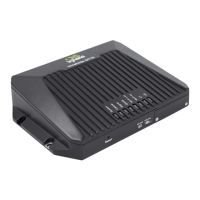InHand VG710 InVehicle Gateway User Manual
16
5.2 OBD
OBD is used to collect vehicle condition data, obtain emission information, and perform fault
diagnosis in real time. Vehicle condition data includes key parameters such as the fuel level, mileage,
driving speed, engine speed, engine load, coolant temperature, and brake pressure. Emission
information includes the volume of AdBlue, the operating and monitoring status of various exhaust
post-processing sensors (such as the exhaust gas sensor and diesel particle filter) and catalysts, etc. In
fault diagnosis, standard fault codes of vehicles and description information can be obtained in real
time, so that vehicle maintenance personnel can learn the vehicle health status in time and locate the
faults.
To collect vehicle data, the gateway is connected to the diagnostic port of the vehicle through the I/O
port of the gateway over the OBD-II or J1939 cable. The cable accessories can be selected or
customized during purchasing. For details about the access method, see Section 4.4 in the VG710
Quick Start Guide. After the gateway starts, the OBD service is automatically enabled to collect key
vehicle condition data and fault code information.
Note:
The power supply and OBD cable of the gateway shall be installed when the vehicle is off.
The vehicle status information is displayed on the OBD status page.
OBD Status:
CAN Link Status (ERROR-ACTIVE indicates that the gateway has successfully connected to the
diagnostic port of the vehicle. Other status indicates that the connection is abnormal or the diagnostic
port of the vehicle is not identified.)
CAN Bitrate (In OBD, the CAN bitrate is automatically adapted, generally 250 kbps or 500 kbps.)
CAN Bind ("OBD" (default) or "Custom")
OBD Connection Status ("Disconnected", "Connecting", or "Connected")
OBD Protocol Type (OBD-II or J1939)

